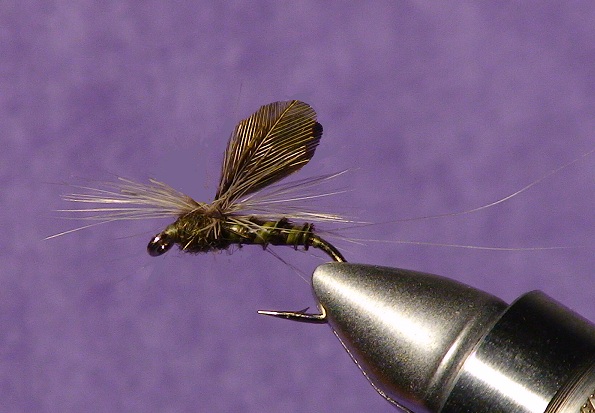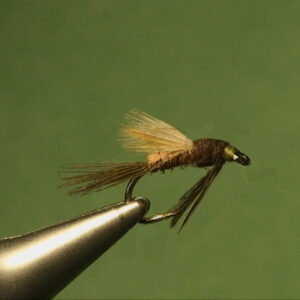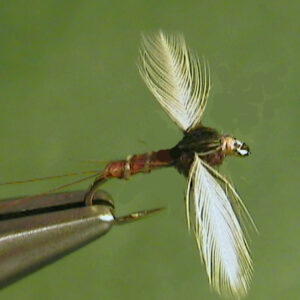Hook Size: 12/14
The Perfect Fly Quill Gordon Dun is an excellent imitation of the adult stage of life of the mayfly. It imitates the mayfly as it drifts or floats on the surface, drying it wet wings enough to fly off the water onto the banks, bushes or trees where it will eventually change into the spinner stage of life. It even imitates the dun down to two or three tails and it two upright wings. It is fished on the surface as a dry fly. It should be treated with floatant.
The Quill Gordon duns emerge from the slower moving water near the fast water the
nymphs were raised in. Before departing the water they may well be caught up in strong
currents. Since they hatch from cold water during cold weather, they may take some time
to dry their wings staying on the surface for a lengthy time. This means that they may be
drifting on the surface for some time, depending on the air and water temperature, and of
course, available for trout to eat during this time. In other words, there are times the dun
imitations work great and times where they do not work at all during the hatch depending
on the conditions.
By the way, if you have any question as to whether on not the mayfly is a Quill Gordon,
notice the heart shaped marks on their legs. These femoral markings are hard to miss
and if the mayfly has them, it is a Quill Gordon. There are other species of this same
genus that have these marking but at the time of the year the Quill Gordon hatch occurs,
you wouldn’t see one of them.
Dun Presentation:
Fish the dun imitation in the current seams (where the slower moving water meets the
faster moving water) at the edges of pockets formed by boulders and large rocks. Up
stream or up and across presentations work best.The pocket water is usually fairly rough
and fast water. The pockets themselves can have smoother, calmer water. Approach the
area you want to place your fly as slowly and quietly as possible. If you are wading you
want to move slowly and make certain you don’t move the cobble, rocks, etc. around on
the bottom. Make short cast and Keep the fly line out of the water as much as possible to
help prevent drag. If you cast up and across, you will probably have to mend your line.
You want the fly to drift down one of the two current seams formed by the boulder. The
trout feeding on the duns are usually located at the ends of the seams.
Sometimes this water is caught up in a long run. In that case you would want your dry fly
dun imitation to drift all the way to the slower water near the end of the run. This usually
requires a much longer cast than fishing the seams of the pockets. These duns may drift
for several feet. You can usually see or hear the trout take them, so pay attention to the
water. This can clue you in on exactly where the fish are positioned. In rough pocket
water it is almost impossible to describe every place they could possible be, so watch the
water.
As I said, trout don’t always feed on the duns. It depends on the water temperature (for
one thing) and how long the trout have had to adjust to the changes in water
temperature. For example, If the water rises to fifty degrees and continues on up to the
mid-fifties and stays there for a while, you can just about be assured the trout will readily
take the duns on the surface.
You will hear anglers say “the trout aren’t looking up”. This is what they assume is
happening when they can’t get the trout to take their dry fly. Well, sorry guys, the trout
are always looking up. They don’t see the same way us humans see things. Without
getting technical, they see forward, almost all around themselves. If is just that they are
not feeding on the duns on the surface. They are probably feeding on the emerging
nymphs that are much easier for them to catch. If you don’t get any action on the dry fly,
switch to the wet fly and you probably will.
Copyright 2013 James Marsh



